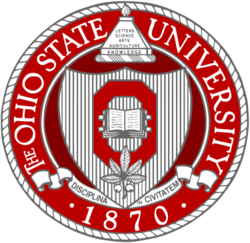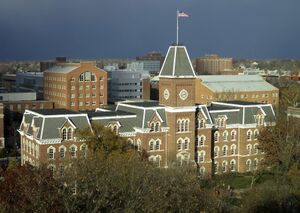Ohio State University
(University) | |
|---|---|
 | |
| Motto | Disciplina in civitatem (Latin) |
| Formation | 1870 |
| Type | PublicLand grantSea grantSpace grant |
| Sponsored by | Hewlett Foundation |
| Other name | Buckeyes |
| With nearly 50,000 undergraduate students and nearly 15,000 graduate students, Ohio State is one of the largest American universities. | |
The Ohio State University, commonly Ohio State or OSU, is a public land-grant research university in Columbus, Ohio. Founded in 1870 as the state's land-grant university and the ninth university in Ohio with the Morrill Act of 1862,[1] the university was originally known as the Ohio Agricultural and Mechanical College. The college originally focused on various agricultural and mechanical disciplines but it developed into a comprehensive university under the direction of then-Governor (later, U.S. president) Rutherford B. Hayes, and in 1878 the Ohio General Assembly passed a law changing the name to "the Ohio State University".[2] The main campus in Columbus, Ohio, has since grown into the third-largest university campus in the United States.[3] The university also operates regional campuses in Lima, Mansfield, Marion, Newark, and Wooster.
Past and present students and faculty include five Nobel Prize laureates, seven Pulitzer Prize winners, six U.S. Senators, 15 U.S. Representatives, and 104 Olympic medalists (46 gold, 35 silver, and 23 bronze).
Contents
History
The proposal of a manufacturing and agriculture university in central Ohio was initially met in the 1870s with hostility from the state's agricultural interests and competition for resources from Ohio University, which was chartered by the Northwest Ordinance, and Miami University. Championed by the Republican governor Rutherford B. Hayes, the Ohio State University was founded in 1870 as a land-grant university under the Morrill Act of 1862 as the Ohio Agricultural and Mechanical College. The school was originally within a farming community on the northern edge of Columbus. While some interests in the state had hoped the new university would focus on matriculating students of various agricultural and mechanical disciplines, Hayes manipulated both the university's location and its initial board of trustees towards a more comprehensive educational mission. The university opened its doors to 24 students on September 17, 1873. In 1878 the first class of six men graduated. The first woman graduated the following year.[4]
Also in 1878, the Ohio legislature recognized an expanded scope for the university by changing its name to "the Ohio State University".[5] The definite article "the" is part of Ohio State's legal name; since at least the 1990s, Ohio State alumni, especially NFL players, have emphasized the "the" when referring to their school ("the Ohio State University").[6] In 2019 Ohio State filed for trademark protection of "the" when it is used to refer to Ohio State;[7] the application was denied.[8]
Ohio State began accepting graduate students in the 1880s, and in 1891, the school saw the founding of its law school, Moritz College of Law. It would later acquire colleges of medicine, dentistry, optometry, veterinary medicine, commerce, and journalism in subsequent years. In 1916 Ohio State was elected into membership in the Association of American Universities.
Michael V. Drake, former chancellor of the University of California, Irvine, became the 15th president of the Ohio State University on June 30, 2014. He announced on November 21, 2019 that he would be retiring at the end of the 2019–2020 academic year.[9]
On June 3, 2020, the Ohio State Board of Trustees appointed Kristina M. Johnson, former chancellor of the State University of New York as the 16th president of the Ohio State University.[10]
Research
The Ohio State University is among the top 12 U.S. public research universities and 3rd among all universities in industry-sponsored research (National Science Foundation). [11] It is also named as one of the most innovative universities in the nation (U.S. News & World Report) and in the world (Reuters)). In a 2007 report released by the National Science Foundation, Ohio State's research expenditures for 2006 were $652 million, placing it 7th among public universities and 11th overall, also ranking 3rd among all American universities for private industry sponsored research. Research expenditures at Ohio State were $720 million in 2007. In 2006 Ohio State announced it would designate at least $110 million of its research efforts to what it termed "fundamental concerns" such as research towards a cure for cancer, renewable energy sources and sustainable drinking water supplies.[12]
Research facilities include Aeronautical/Astronautical Research Laboratory, Byrd Polar Research Center, Center for Automotive Research (OSU CAR), Chadwick Arboretum, Biomedical Research Tower, Biological Sciences Building, CDME, Comprehensive Cancer Center, David Heart and Lung Research Institute, Electroscience Laboratory, Large Binocular Telescope (LBT, originally named the Columbus Project), Mershon Center for International Security Studies, Museum of Biological Diversity, National Center for the Middle Market, Stone Laboratory on Gibraltar Island, OH, Center for Urban and Regional Analysis and Ohio Agricultural Research and Development Center.
Notable people
Alumni
Ohio State has 580,000 living alumni around the world.[13] Ohio State alumni include Nobel Prize recipients, Pulitzer Prize recipients, Olympic Games gold medalists, UFC champions, and Medal of Honor recipients, ambassadors, as well as Fortune 500 CEOs and members of the Forbes 400 list of the world's wealthiest individuals. Numerous graduates have gone on to become U.S. governors, senators and members of Congress. Fredrick Douglas Patterson, the only African American Car Manufacturer and first to join The Ohio State football program. Ohio State alumni have appeared on the cover of Time magazine twelve times, with the artwork of alumnus Roy Lichtenstein featured on an additional two Time covers. George Steinbrenner, former owner of the New York Yankees who won seven World Series with the team, earned his master's degree from Ohio State. Larry Sanger, one of the founders of Wikipedia, and Steve May, chief technology officer at Pixar, both graduated from Ohio State. Roboticist James S. Albus was named a "Hero of US Manufacturing" by Fortune Magazine in 1997.
Ohio State alumni have been inducted into the Baseball Hall of Fame in Cooperstown, New York, the NFL Hall of Fame and the Basketball Hall of Fame. Its athletes have won a combined eighty-three Olympic medals and three times have received the Sullivan Award as the nation's top amateur athlete.
Faculty
Ohio State's faculty currently includes 21 members of the National Academy of Sciences or National Academy of Engineering, four members of the Institute of Medicine,[14] and 177 elected fellows of the American Association for the Advancement of Science. In 2009, 17 Ohio State faculty were elected as AAAS Fellows. Each year since 2002, Ohio State has either led or been second among all American universities in the number of their faculty elected as fellows to the AAAS.[15][16]
In surveys conducted in 2005 and 2006 by the Collaborative on Academic Careers in Higher Education (COACHE), Ohio State was rated as "exemplary" in four of the seven measured aspects of workplace satisfaction for junior faculty at 31 universities: overall tenure practices, policy effectiveness, compensation, and work-family balance.[17]
In the last quarter century, 32 Ohio State faculty members have received the Guggenheim Fellowship, more than all other public and private Ohio universities combined. In 2008 three Ohio State faculty were awarded Guggenheim Fellowships, placing Ohio State among the top 15 universities in the United States.[18] Since the 2000–2001 award year, 55 Ohio State faculty members have been named as Fulbright Fellows, the most of any Ohio university.[19]
Related Quotations
| Page | Quote | Author | Date |
|---|---|---|---|
| Victor Marchetti | “To the Clandestine Services the universities represented fertile territory for recruiting espionage agents. Most large American colleges enrolled substantial numbers of foreign students, and many of these, especially those from the Third World, were (and are) destined to hold high positions in their home countries in a relatively few years. They were much easier to recruit at American schools — when they might have a need for money, where they could be easily compromised, and where foreign security services could not interfere — than they would be when they returned home. To spot and evaluate these students, the Clandestine Services maintained a contractual relationship with key professors on numerous campuses. When a professor had picked out a likely candidate, he notified his contact at the CIA and, on occasion, participated in the actual recruitment attempt. Some professors performed these services without being on a formal retainer. Others actively participated in agency covert operations by serving as "cut-outs," or intermediaries, and even by carrying out secret missions during foreign journeys.” | Victor Marchetti | 1974 |
| Victor Marchetti | “Helms asked his staff to find out just how many university personnel were under secret contract to the CIA. After a few days of investigation, senior CIA officers reported back that they could not find the answer. Helms immediately ordered a full study of the situation, and after more than a month of searching records all over the agency, a report was handed in to Helms listing hundreds of professors and administrators on over a hundred campuses. But the staff officers who compiled the report knew that their work was incomplete . Within weeks, another campus connection was exposed in the press. The contact was not on the list that had been compiled for the Director.” | Victor Marchetti | 1974 |
Group
| Group | Start | Description |
|---|---|---|
| Moritz College of Law | 1891 | The law school of Ohio State University, |
Sponsor
| Event | Description |
|---|---|
| Hewlett Foundation | Huge foundation setting the agenda by funding lots of deep state projects. |
Alumni on Wikispooks
| Person | Born | Died | Nationality | Summary | Description |
|---|---|---|---|---|---|
| William F. Donnelly | Spook | CIA officer becoming Inspector General of the Agency. | |||
| Xavier Duportet | 7 December 1987 | France | Scientist | Genome architect and founder of Eligo Biotech | |
| Clare Hazell-Iveagh | 1975 | UK | Friend of Ghislaine Maxwell, flew Jeffrey Epstein's Lolita Express 32 times. | ||
| Donald Kagan | 1 May 1932 | US | Academic | ||
| Stephen Kappes | 22 August 1951 | Spook | |||
| John Kasich | 13 May 1952 | Politician | US Republican politician who supported Biden over Trump | ||
| Foy Kohler | 15 February 1908 | 23 December 1990 | Diplomat Spook | US diplomat and cold warrior. Ambassador to the Soviet Union, Assistant Secretary of State for European and Eurasian Affairs, Committee on the Present Danger, Team B, Council on Foreign Relations. | |
| Curtis LeMay | 15 November 1906 | 1 October 1990 | Spook Soldier | ||
| Brian Sandoval | 5 August 1963 | US | Politician Lawyer | ||
| Larry Sanger | US | Businessperson | co-founder of Wikipedia. | ||
| Mahmood Sariolghalam | 1959 | Iran | Academic | US deep state connected Iranian academic | |
| William B. Saxbe | 24 June 1916 | 24 August 2010 | Politician | ||
| Gene Sharp | 21 January 1928 | 28 January 2018 | US | Scientist | Political scientist credited with writing handbooks for non-violent resistance, which are also used in color revolutions. |
| Thomas E. Wheeler | 5 April 1946 | ||||
| Makarim Wibisono | 8 May 1947 |
References
- ↑ ://web.archive.org/web/20110511120058/http://cio.chance.berkeley.edu/chancellor/sp/flagship.htm
- ↑ https://web.archive.org/web/20140815234443/http://library.osu.edu/find/collections/the-ohio-state-university-archives/buckeye-history/faqs/#1
- ↑ https://www.usnews.com/education/best-colleges/the-short-list-college/articles/2011/11/29/10-universities-with-the-most-undergraduate-students
- ↑ https://web.archive.org/web/20150216131558/http://news.osu.edu/history.html
- ↑ The government of Ohio, in its official web site listing the state's compiled laws: "3335.01 The Ohio State University. The educational institution originally designated as the Ohio agricultural and mechanical college shall be known as "The Ohio State University." http://codes.ohio.gov/orc/3335
- ↑ {https://www.sbnation.com/nfl/2018/9/9/17402796/player-introductions-primetime-football-nbc-sunday-night-football
- ↑ https://www.usatoday.com/story/sports/ncaaf/bigten/2019/08/14/ohio-state-university-files-trademark-word-the-school-apparel/2006567001/
- ↑ https://www.cbsnews.com/news/ohio-state-university-trademark-the-osu-cant-trademark-the-word-the-patent-office-says/
- ↑ https://president.osu.edu/story/presidential-transition-announcement
- ↑ https://www.cleveland.com/news/2020/06/ohio-state-trustees-confirm-suny-chancellor-kristina-m-johnson-as-next-president.html
- ↑ http://undergrad.osu.edu/majors-and-academics/quick-facts%7Cpublisher=Ohio State University
- ↑ https://web.archive.org/web/20071015154250/http://milwaukee.bizjournals.com/columbus/stories/2007/10/08/daily3.html
- ↑ https://www.osu.edu/alumni/about-us/%7Ctitle=Ohio State Alumni Association - The Ohio State University
- ↑ https://web.archive.org/web/20080725104455/http://iom.edu/CMS/2951/16476.aspx
- ↑ https://web.archive.org/web/20140115191304/http://php.aaas.org/about/aaas_fellows/list.php
- ↑ https://web.archive.org/web/20161207161325/http://researchnews.osu.edu/archive/aaasfellows2009.htm
- ↑ https://web.archive.org/web/20091228104837/http://gseacademic.harvard.edu/~coache/reports/20070123.html
- ↑ https://web.archive.org/web/20080731002206/http://www.gf.org/newfellow.html
- ↑ https://web.archive.org/web/20131018035114/http://www.cies.org/us_scholars/us_dir.html
